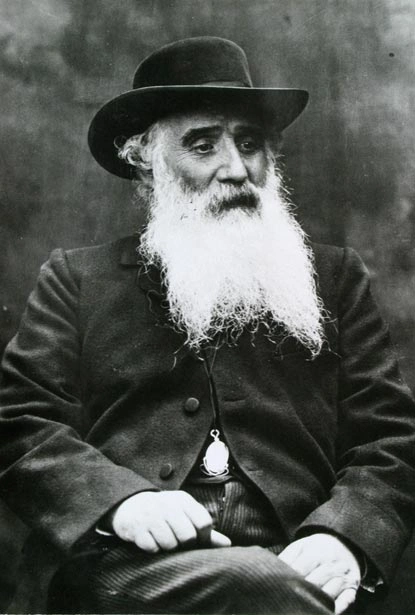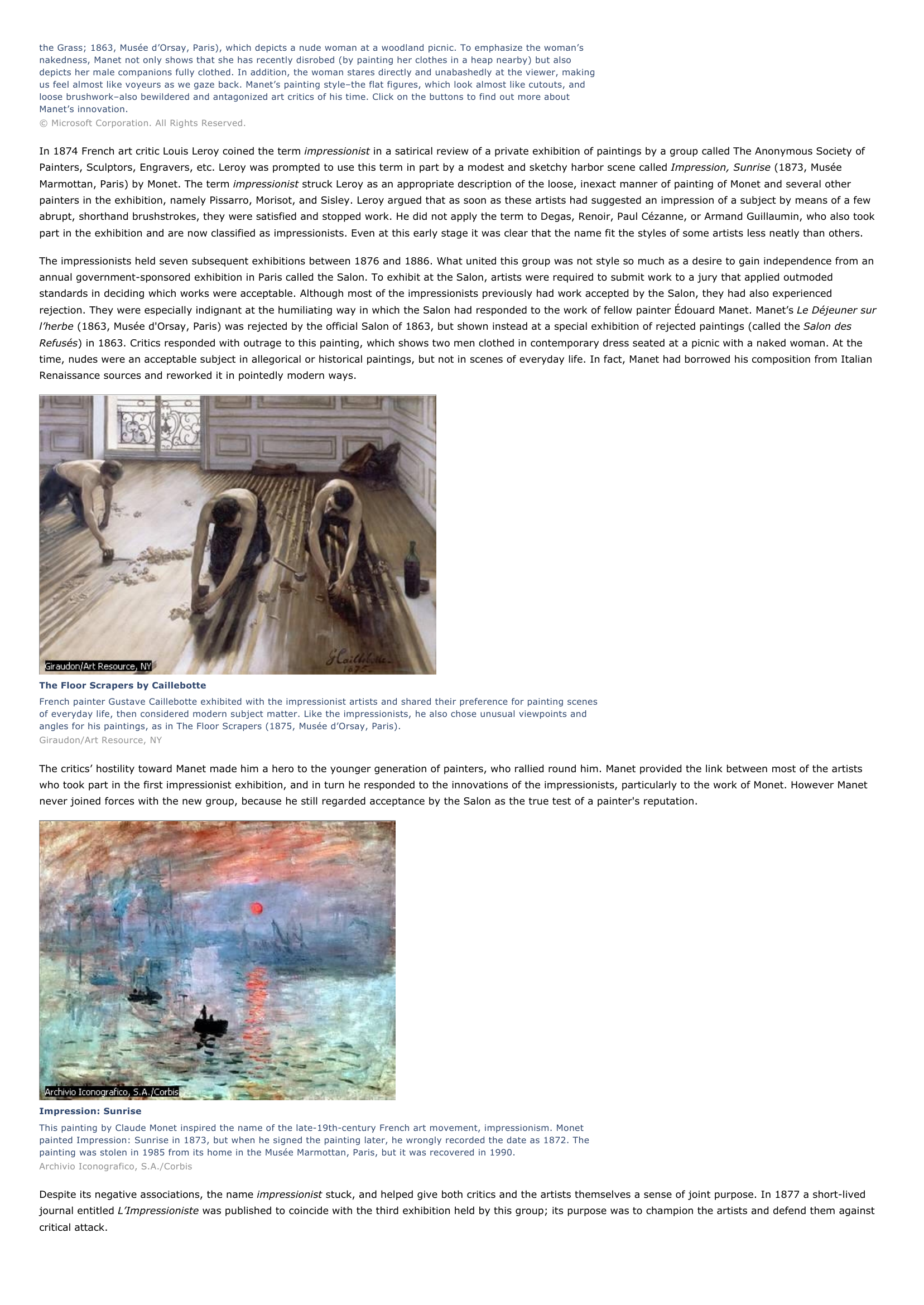Impressionism (art) I INTRODUCTION Vegetable Garden at the Hermitage, Pontoise Vegetable Garden at the Hermitage, Pontoise (1879) was painted by the French artist Camille Pissarro.
Publié le 12/05/2013

Extrait du document


«
the Grass; 1863, Musée d’Orsay, Paris), which depicts a nude woman at a woodland picnic.
To emphasize the woman’snakedness, Manet not only shows that she has recently disrobed (by painting her clothes in a heap nearby) but alsodepicts her male companions fully clothed.
In addition, the woman stares directly and unabashedly at the viewer, makingus feel almost like voyeurs as we gaze back.
Manet’s painting style–the flat figures, which look almost like cutouts, andloose brushwork–also bewildered and antagonized art critics of his time.
Click on the buttons to find out more aboutManet’s innovation.© Microsoft Corporation.
All Rights Reserved.
In 1874 French art critic Louis Leroy coined the term impressionist in a satirical review of a private exhibition of paintings by a group called The Anonymous Society of Painters, Sculptors, Engravers, etc.
Leroy was prompted to use this term in part by a modest and sketchy harbor scene called Impression, Sunrise (1873, Musée Marmottan, Paris) by Monet.
The term impressionist struck Leroy as an appropriate description of the loose, inexact manner of painting of Monet and several other painters in the exhibition, namely Pissarro, Morisot, and Sisley.
Leroy argued that as soon as these artists had suggested an impression of a subject by means of a fewabrupt, shorthand brushstrokes, they were satisfied and stopped work.
He did not apply the term to Degas, Renoir, Paul Cézanne, or Armand Guillaumin, who also tookpart in the exhibition and are now classified as impressionists.
Even at this early stage it was clear that the name fit the styles of some artists less neatly than others.
The impressionists held seven subsequent exhibitions between 1876 and 1886.
What united this group was not style so much as a desire to gain independence from anannual government-sponsored exhibition in Paris called the Salon.
To exhibit at the Salon, artists were required to submit work to a jury that applied outmodedstandards in deciding which works were acceptable.
Although most of the impressionists previously had work accepted by the Salon, they had also experiencedrejection.
They were especially indignant at the humiliating way in which the Salon had responded to the work of fellow painter Édouard Manet.
Manet’s Le Déjeuner sur l’herbe (1863, Musée d'Orsay, Paris) was rejected by the official Salon of 1863, but shown instead at a special exhibition of rejected paintings (called the Salon des Refusés ) in 1863.
Critics responded with outrage to this painting, which shows two men clothed in contemporary dress seated at a picnic with a naked woman.
At the time, nudes were an acceptable subject in allegorical or historical paintings, but not in scenes of everyday life.
In fact, Manet had borrowed his composition from ItalianRenaissance sources and reworked it in pointedly modern ways.
The Floor Scrapers by CaillebotteFrench painter Gustave Caillebotte exhibited with the impressionist artists and shared their preference for painting scenesof everyday life, then considered modern subject matter.
Like the impressionists, he also chose unusual viewpoints andangles for his paintings, as in The Floor Scrapers (1875, Musée d’Orsay, Paris).Giraudon/Art Resource, NY
The critics’ hostility toward Manet made him a hero to the younger generation of painters, who rallied round him.
Manet provided the link between most of the artistswho took part in the first impressionist exhibition, and in turn he responded to the innovations of the impressionists, particularly to the work of Monet.
However Manetnever joined forces with the new group, because he still regarded acceptance by the Salon as the true test of a painter's reputation.
Impression: SunriseThis painting by Claude Monet inspired the name of the late-19th-century French art movement, impressionism.
Monetpainted Impression: Sunrise in 1873, but when he signed the painting later, he wrongly recorded the date as 1872.
Thepainting was stolen in 1985 from its home in the Musée Marmottan, Paris, but it was recovered in 1990.Archivio Iconografico, S.A./Corbis
Despite its negative associations, the name impressionist stuck, and helped give both critics and the artists themselves a sense of joint purpose.
In 1877 a short-lived journal entitled L’Impressioniste was published to coincide with the third exhibition held by this group; its purpose was to champion the artists and defend them against critical attack..
»
↓↓↓ APERÇU DU DOCUMENT ↓↓↓
Liens utiles
- Modern Art I INTRODUCTION American Gothic American Gothic was painted by the 20th-century American artist Grant Wood in 1930.
- Édouard Manet I INTRODUCTION Manet: Tradition and Innovation French impressionist painter Édouard Manet shocked art audiences in Paris with Le déjeuner sur l'herbe (The Luncheon on the Grass; 1863, Musée d'Orsay, Paris), which depicts a nude woman at a woodland picnic.
- Rembrandt I INTRODUCTION Rembrandt (1606-1669), Dutch baroque artist, who ranks as one of the greatest painters in the history of Western art.
- Henri Matisse Henri Matisse (1869-1954), French artist, leader of the fauve group (see Fauvism), regarded as one of the great formative figures in 20th-century art, a master of the use of color and form to convey emotional expression.
- Western Music I INTRODUCTION Bizet's Carmen Georges Bizet's Carmen, first performed in Paris in 1875, was a milestone in the history of French opera.
















